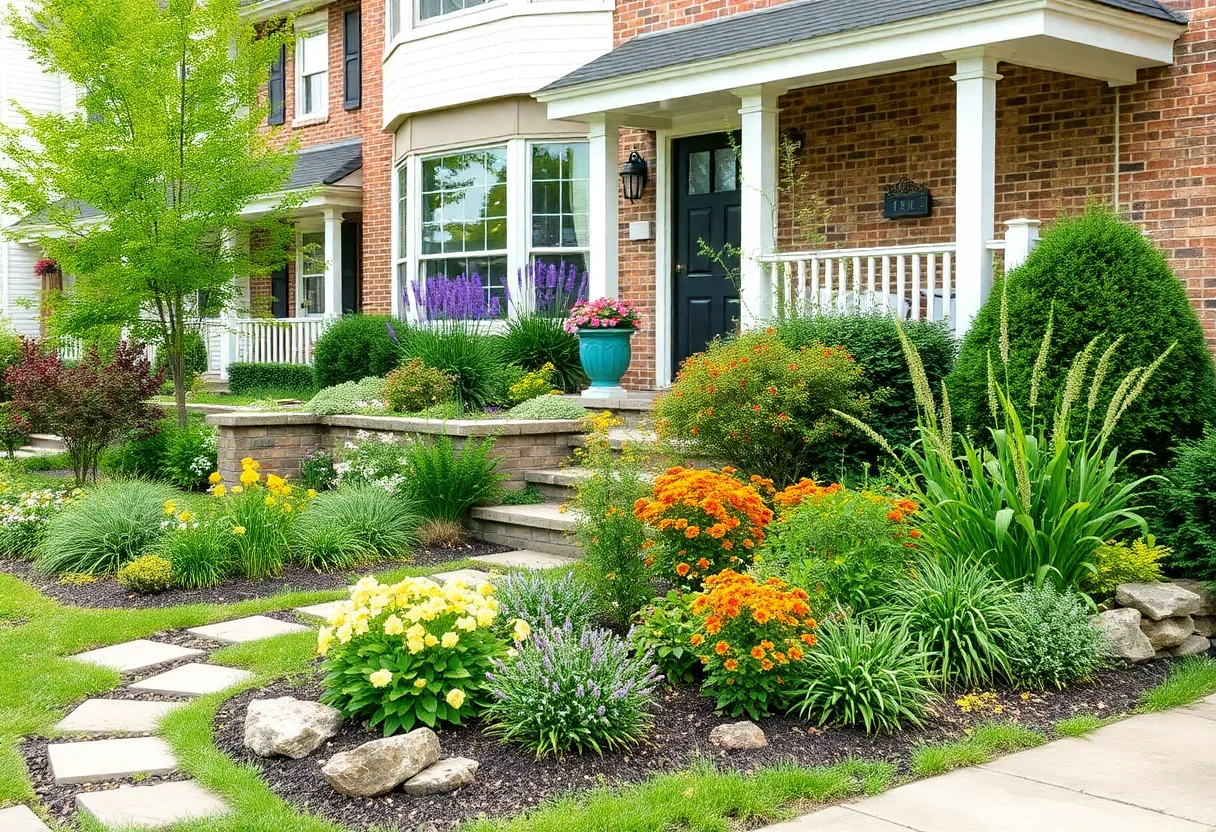Designing a Charming Front Yard Garden in Philadelphia: A Comprehensive Guide
Creating an inviting and sustainable front yard garden in Philadelphia requires careful planning tailored to the city’s distinctive climate and aesthetic preferences. From selecting native plants to integrating durable hardscaping elements, every aspect contributes to a low-maintenance, visually appealing landscape. This guide outlines essential strategies to help you craft a charming front yard that enhances your home’s curb appeal and supports local ecosystems.
1. Embrace Native Plants
Choosing native plants is foundational for a sustainable and low-upkeep garden. Native species are naturally adapted to Philadelphia’s climate, which experiences hot summers and cold winters, reducing the need for supplemental watering, fertilization, and pest control. Incorporating these plants increases resilience and benefits local wildlife by providing essential food and habitat sources.
Recommended Native Plants for Philadelphia Gardens
- Amsonia hubrichtii: Features feathery foliage with vivid golden hues in fall, bringing texture and seasonal color.
- Asclepias tuberosa: Also known as butterfly weed, it produces bright orange flowers that attract pollinators like monarch butterflies and bees.
- Panicum ‘Northwind’: An ornamental grass offering upright growth, gentle movement, and visual interest throughout the seasons.
- Phlox subulata: A resilient evergreen groundcover with vibrant spring blooms, ideal for borders and edging.
Incorporate these plants thoughtfully within your landscape to support local pollinators and wildlife, creating a vibrant, eco-friendly environment.
2. Plan for Year-Round Interest
A truly inviting garden maintains visual appeal across all seasons. To achieve this, select a diverse mix of plant types that provide continuous interest:
Spring
- Early-blooming bulbs such as daffodils and tulips.
- Deciduous shrubs like lilacs that burst into fragrance and flowers.
Summer
- native perennials with lush foliage, such as coneflowers and black-eyed Susans.
- Grasses that sway gently in the breeze, adding movement.
Fall
- Trees and shrubs showcasing vibrant foliage in shades of red, orange, and yellow.
- Continued blooming native perennials for late-season color.
Winter
- Evergreens such as holly or juniper that maintain structure and color.
- Ornamental grasses and seed heads that add texture and interest.
This deliberate diversity fosters a dynamic landscape and ensures year-round visual engagement.
3. Incorporate Hardscaping Elements
Hardscaping enhances design, functionality, and durability. Well-chosen features create structure and reduce ongoing maintenance:
Natural Stone Walls
Timeless and durable, stone walls define space, prevent erosion, and serve as seating or planting beds.
Permeable Pathways
Materials like brick pavers or flagstone facilitate water drainage, prevent puddling, and add aesthetic charm.
Raised Beds
These provide controlled soil conditions for designated edible or ornamental planting areas. They also help elevate plants for visual impact.
By integrating these elements, you create a functional layout that is pleasing, practical, and environmentally friendly.
4. Use Clean Edges to Define Spaces
Clear, crisp boundaries contribute to a neat and cohesive appearance. Options include:
- Mulched Edges: Using mulch to delineate garden beds reduces weed growth and gives a tidy look.
- Natural Stone Borders: Provide rustic charm while effectively preventing plant encroachment into lawn areas.
- Defined Pathways: Establish clear routes through your yard, protecting plants and guiding visitors.
Careful edge definition enhances overall organization and visual harmony in your landscape design.
5. Incorporate Edible Plants
Blending food-producing plants with ornamental landscaping, often called foodscaping, adds both style and functionality:
- Maximize limited space by planting vegetables, herbs, or edible flowers alongside ornamental plants.
- Create vibrant visual contrasts with colorful produce and flowering plants.
- Reduce your carbon footprint by growing your own fresh food close to home.
Group edible plants according to their sunlight, water, and nutrient requirements to ensure healthy growth. For example, place sun-loving vegetables like tomatoes in warm, sunny spots, and shade-tolerant herbs under taller shrubs or trees.
6. Implement Sustainable Practices
Sustainable gardening promotes resilience, conserves resources, and minimizes environmental impact. Key practices include:
Rain Gardens
Designing depressions planted with native soil and plants allows rainwater to infiltrate, reducing runoff and supporting groundwater recharge.
Composting
Transform organic waste into rich compost to nourish your plants naturally, reducing dependence on chemical fertilizers.
Native Mulches
Use local bark or wood chips to retain soil moisture, suppress weeds, and improve soil health over time.
Adopting these practices enhances the sustainability and health of your garden while decreasing maintenance efforts.
7. Add Lighting and Decorative Elements
Thoughtful outdoor lighting and accents extend usability and ambiance into evening hours. Ideas include:
- Pathway Lighting: Solar or low-voltage fixtures guide visitors safely and accentuate pathways.
- Accent Lighting: Highlight feature plants, sculptures, or architectural elements to create focal points.
- Decorative Features: Add birdbaths, benches, trellises, or sculptures to inject personality and charm into your yard.
When thoughtfully integrated, these elements transform your front yard into a welcoming, stylish space.
Conclusion
Designing a charming front yard garden in Philadelphia hinges on strategic plant selection, seasonality, functional hardscaping, and eco-friendly practices. Prioritizing native plants and sustainable methods ensures longevity, low maintenance, and ecological benefits. Incorporating hardscaping and decorative features enhances aesthetic appeal and usability. Ultimately, a thoughtfully designed landscape elevates your home’s curb appeal while supporting local biodiversity and environmental health.
Frequently Asked Questions
What are the best native plants for a Philadelphia front yard?
Native plants like Amsonia hubrichtii, Asclepias tuberosa, Panicum ‘Northwind’, and Phlox subulata are ideal. They adapt well to local conditions, attract pollinators, and support native wildlife.
How can I ensure my garden has visual interest throughout the year?
Choose a mix of evergreens, deciduous shrubs, and perennials that bloom or show color in different seasons. Incorporate early bloomers, summer foliage, vibrant fall color, and winter structural plants to maintain interest year-round.
What sustainable practices are recommended for urban front yard gardens?
Implement rain gardens to manage stormwater, practice composting organic waste, and use native mulches to conserve water and improve soil health, all of which promote sustainability and reduce maintenance.
Key Features of a Philadelphia Front Yard Garden
| Feature | Benefit | Implementation Tips |
|---|---|---|
| Native Plants | Resilient, low water, habitat support | Use species like Amsonia, Asclepias, and native grasses |
| Year-Round Interest | Constant visual appeal | Combine deciduous, evergreen, and flowering plants |
| Hardscaping Elements | Adds structure, reduces maintenance | Incorporate stone walls, pathways, raised beds |
| Sustainable Practices | Environmental health, low upkeep | Rain gardens, composting, native mulching |
| Lighting & Accents | Night-time ambiance, focal points | Pathway lighting, decorative features |
Author: STAFF HERE PHILADELPHIA WRITER
The PHILADELPHIA STAFF WRITER represents the experienced team at HEREPhiladelphia.com, your go-to source for actionable local news and information in Philadelphia, Philadelphia County, and beyond. Specializing in "news you can use," we cover essential topics like product reviews for personal and business needs, local business directories, politics, real estate trends, neighborhood insights, and state news affecting the area—with deep expertise drawn from years of dedicated reporting and strong community input, including local press releases and business updates. We deliver top reporting on high-value events such as Mummers Parade, Philadelphia Flower Show, and Thanksgiving Day Parade. Our coverage extends to key organizations like the Greater Philadelphia Chamber of Commerce and United Way of Greater Philadelphia, plus leading businesses in telecommunications, food services, and healthcare that power the local economy such as Comcast, Aramark, and Children's Hospital of Philadelphia. As part of the broader HERE network, we provide comprehensive, credible insights into Pennsylvania's dynamic landscape.





